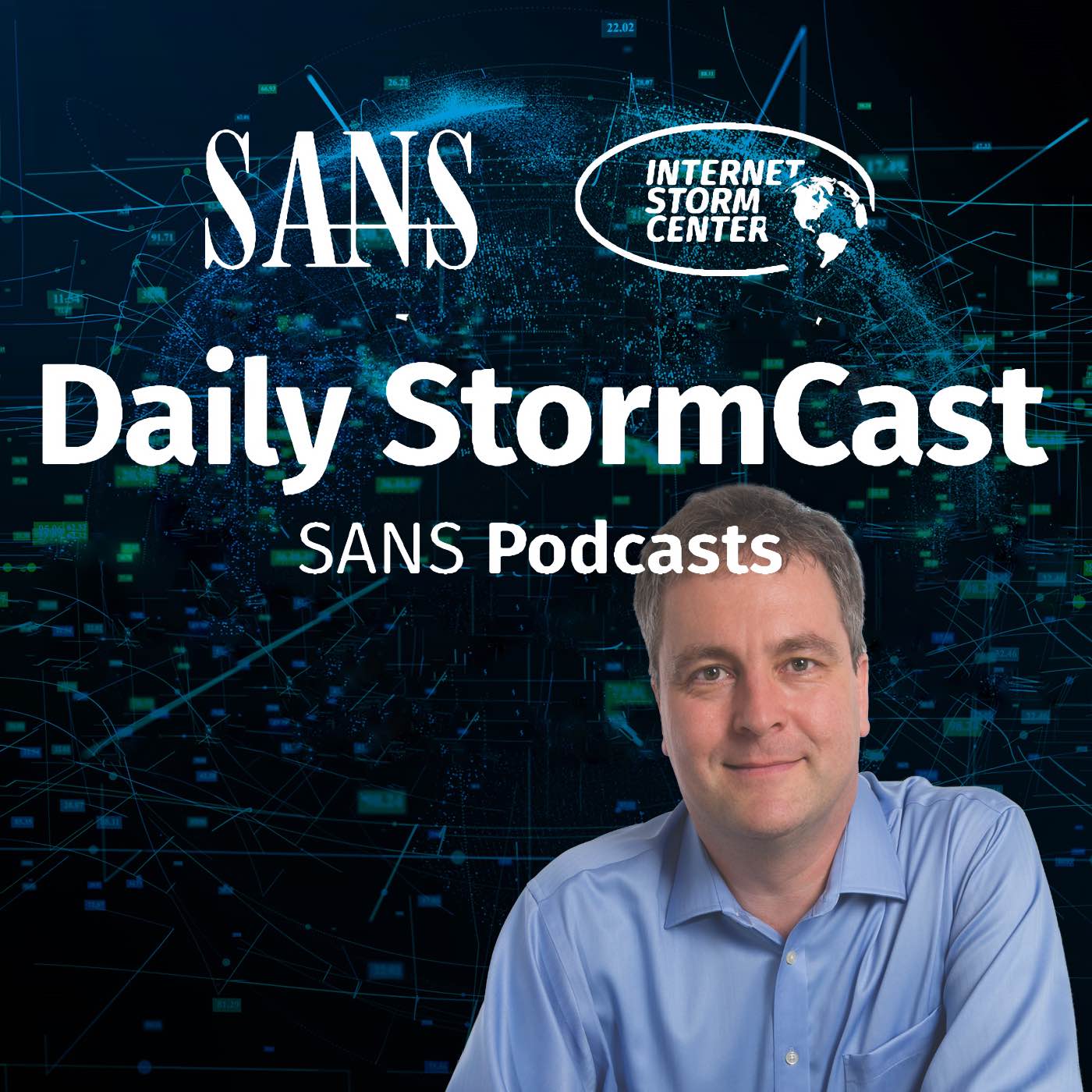Handler on Duty: Didier Stevens
Threat Level: green
Podcast Detail
SANS Stormcast Friday Mar 21st: New Data Feeds; SEO Spam; Veeam Deserialization; IBM AIX RCE;
If you are not able to play the podcast using the player below: Use this direct link to the audio file: https://traffic.libsyn.com/securitypodcast/9374.mp3
My Next Class
| Application Security: Securing Web Apps, APIs, and Microservices | Orlando | Mar 29th - Apr 3rd 2026 |
| Network Monitoring and Threat Detection In-Depth | Amsterdam | Apr 20th - Apr 25th 2026 |
Some New Data Feeds and Little Incident
We started offering additional data feeds, and an SEO spamer attempted to make us change a link from an old podcast episode.
https://isc.sans.edu/diary/Some%20new%20Data%20Feeds%2C%20and%20a%20little%20%22incident%22./31786
Veeam Deserialization Vulnerability
Veeam released details regarding the latest vulnerablity in Veeam, pointing out the insufficient patch applied to a prior deserialization vulnerability.
https://labs.watchtowr.com/by-executive-order-we-are-banning-blacklists-domain-level-rce-in-veeam-backup-replication-cve-2025-23120/
IBM AIX Vulnerablity
The AIX NIM service is vulnerable to an unauthenticated remote code execution vulnerability
https://www.ibm.com/support/pages/node/7186621
thanks Chris Mosby for Spotify comment
Discussion
New Discussions closed for all Podcasts older than two(2) weeks
Please send your comments to our Contact Form
| Application Security: Securing Web Apps, APIs, and Microservices | Orlando | Mar 29th - Apr 3rd 2026 |
| Network Monitoring and Threat Detection In-Depth | Amsterdam | Apr 20th - Apr 25th 2026 |
| Application Security: Securing Web Apps, APIs, and Microservices | San Diego | May 11th - May 16th 2026 |
| Network Monitoring and Threat Detection In-Depth | Online | Arabian Standard Time | Jun 20th - Jun 25th 2026 |
| Network Monitoring and Threat Detection In-Depth | Riyadh | Jun 20th - Jun 25th 2026 |
| Application Security: Securing Web Apps, APIs, and Microservices | Washington | Jul 13th - Jul 18th 2026 |
| Application Security: Securing Web Apps, APIs, and Microservices | Las Vegas | Sep 21st - Sep 26th 2026 |
Podcast Transcript
Hello and welcome to the Friday, March 21st, 2025 edition of the SANS Internet Storm Center's Stormcast. My name is Johannes Ullrich and today I'm recording from Jacksonville, Florida. Well, today I wrote a little bit of mixed diary. First of all, just introducing that we reorganized some of our data feeds a little bit. We have some more or less static reports that we recreate once an hour, once a day, depending on the report. And they may be more efficient for you if you want to use our data. Instead of querying, for example, our API for individual IP addresses, you can download here, for example, our Threat Intel feed that lists all of the IP addresses for which we had recently activity. And then some labels going with that IP address. That sort of should speed things up and, of course, also takes a little bit of load off our API if you're using this. In addition, sort of a little incident here, I called it. It's something that we have seen in the past but haven't seen for a while. And yesterday we got yet another email from sort of a search engine optimization scam. That's at least sort of where I put it. The email itself basically claims that a link that we have in a podcast episode is no longer active. And they give you a new URL to replace that link with. Well, the problem is that, first of all, the email didn't come from the organization that actually owned this particular webpage. It happened to be the Electronic Frontier Foundation. And they're going sort of now after these popular links with these scams. And then, of course, the new link they offered, it had the same content as the original page. Basically, just copy-pasted that. But it also was part of one of those essay writing websites. So not really what I would consider a legitimate business. And they essentially just try to drive click-throughs, advertisement to their page. That's really what it's all about. It's a little scam. So if you run a blog or something like this, you may also get some of these emails. Just be careful before you update any links. Make sure the old one is actually gone. Like in this case, the old one was still perfectly fine. And then that the new content is actually related to the original owner of the content. Well, lately I started referring to Veeam, sort of a friend of the show, because they always are good for new vulnerability stories. The other company that is often mentioned then as well is watchTowr. Because they then, of course, take these vulnerabilities and tell us everything that went wrong. I sort of really like the watchTowr approach here. It's maybe a little bit sort of, I don't know, my dark heart here. Like to make fun of stuff like this. Particularly if it's large companies that probably should do better. But either way, let's talk a little bit about what happened here. It's another deserialization vulnerability. Deserialization vulnerabilities have been quite common. They usually affect software written like in .NET, Java, most of all. Can happen in any object -oriented language. But typically it more happens in Java, .NET because it does happen in enterprise systems that often accept arbitrary objects. And the reason deserialization exists is that objects aren't just data. They're data and code. And if you deserialize the wrong object, well, then you end up with arbitrary code execution. So there are two ways to avoid deserialization, very simplistically speaking. One is, hey, let's set up an allow list of safe objects that we actually want to deserialize. The other object and or the other method is what Veeam did. Well, let's just find a list of all the bad objects and then set up a list of all those bad objects and just not allow them. So the block list approach. And anybody who has done anything in security probably realizes that it's really hard to impossible to get the block list approach. Right. And that's exactly what's going on here with Veeam. I don't know enough about the product to understand why they can't do an allow list here. Like another example where this happened was like WebLogic, for example. They did a similar thing with block lists. Didn't really work very well. But WebLogic is middleware that has to accept all kinds of objects. Really difficult for them to sort of come up with an allow list. For a backup system like Veeam, I would hope there is a better way of doing it. But again, I'm not that familiar with Veeam to really speak to the difficulties that they encountered in doing anything like, you know, reasonably safe here. Anyway, keep patching Veeam and there will be probably more just to learn a little bit from what happened with WebLogic or other software like this. Desetialization vulnerabilities don't always happen as the object is instantiated. They can happen on the destructor. They can happen when there are exceptions being triggered. And usually attackers, once they're done finding all the bad objects that are causing code execution on instantiation, and once that block list is reasonably good, well, they look for these other methods to then, you know, again, exploit it. So there's probably a number of additional vulnerabilities coming here. And we also have two critical vulnerabilities in IBM's AIX operating system. They both affect NIM. NIM is short for the network installation management. It allows essentially to set up the systems over the network. So it does allow for remote code execution, but should ask for authentication. The problem is that in this particular case, due to this vulnerability that hasn't really been specified in any additional detail, well, these code execution can happen without any authentication. And then we have the latest way to steal NTLM hashes. This time it's via library-ms files. Well, the vulnerability was recently patched, but now there is a very trivial proof -of-concept exploit showing how to exploit this vulnerability. I read the other day that the problem with these NTLM hash leaks is that this is really sort of how the operating system Windows was designed to work, to basically just automatically authenticate. And that's really sort of being abused here. And that's why we keep having, you know, basically any place where a remote URL could be used as a file name, which also is pretty much anywhere where a file name could be used. Well, you have a potential for NTLM leakage. So the real fix again here is block outbound port 445 at least. And then also, you know, disable NTLM hashes as much as possible. Well, and this is it for today. So thanks for listening. And thanks, Chris Mosby here for leaving a nice Spotify comment. So if you haven't done so yet, haven't had a comment on Apple Podcasts for a while, for example, if you're using that to subscribe to this podcast. And with that, well, I'm probably off to the dog park then reprocessing this podcast. Hopefully I won't forget about it and you'll be able to listen on it on Friday morning. And that's it. Thanks and talk to you again on Monday. Bye.











